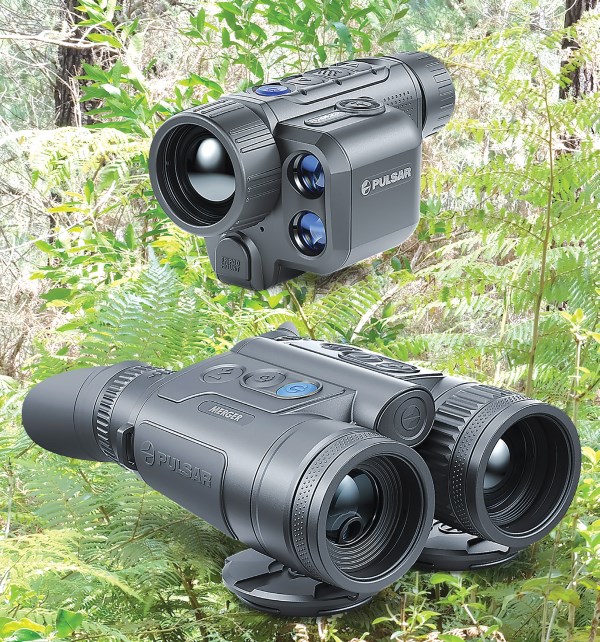
I recently wrote two Optically Speaking articles about the new Pulsar Merger LRF XQ35 thermal binocular and the Pulsar Axion 2 LRF XQ35 thermal monocular. I have since spent more time using these devices. This article is a summary of my experience and conclusions.
At first glance, the size and weight is the most noticeable difference because the Merger LRF is a binocular (bi-ocular) weighing 0.83kg, whilst the Axion 2 LRF is a compact monocular weighing 0.47kg and able to fit into a pocket. I found that both units are easy to carry and use, but I personally find that the Merger is more comfortable to carry due to its neck strap. The Merger is also fitted with a proximity sensor that switches the unit into ‘sleep mode’ when moved away from the face and then instant start-up when using again; I really like this feature.
Despite having the same sensor and objective lens, the optical characteristics are different due to the Merger having a larger AMOLED display. Both devices have the same field-of-view, but the base magnification of the Merger is 3x, whilst the base magnification of the Axion is 2x. The Merger is better for spotting and identifying objects, however, I found that the Axion was better for walking at night due to its lower magnification.
My first experience with the Merger LRF XQ35 was a prolonged night-time walk with the Merger around my neck and Axion in my hand for comparison. I found that I would look through the Axion when walking, before switching to the Merger for scanning. To begin with, I found this confusing because I thought both units had the same magnification. Once I had spotted the base magnification at the bottom of each viewfinder, I understood why. If you do a lot of night walking, the Axion would be a good choice.
The Pulsar Merger LRF XQ35 with its two eyepieces has a far superior viewing experience than a monocular. The image is larger and the experience more immersive. It’s a bit like going to a cinema and watching with both eyes against watching with one eye closed! Detail is better and it feels far more natural. As well as the extra size and weight of the Merger, there is also a price difference.
The Axion 2 LRF XQ35 is $3,599 while the Merger LRF XQ35 is $6,999. If you want the extra image clarity and comfort of a binocular thermal imager, the extra cost is well worth it.
On the other hand, the Pulsar Axion 2 LRF XQ35 is lighter, smaller, better able at providing night-time navigation and costs less. Slipping it into a jacket pocket when not in use is very handy. Everyone will have their own likes, dislikes, budget and image requirements. Both devices deliver an excellent thermal imaging option, but in their own way, each is quite different.
Common features:
• Manufactured in Europe by Pulsar
• 384×288 Lynred STD-810/833 TWS Qualified sensor
• NETD <25mK
• 35mm f1.0 precision germanium lenses
• Laser rangefinder
• Video recording and streaming via Wi-Fi
• Firmware update and remote control via Stream Vision 2
• Advanced image processing, control and colour palettes
• Fully waterproof Mg alloy housing
• Quick-change battery (Merger also has an internal back-up battery)
• 3 year warranty
For more information please visit advancedoptics.nz













